I. Like Everyone Born in the 1940s, My Mother Was a Fan of Elvis
Wilhelm Sasnal on the role of chance in documenting the world, and the connections between film, Land Art and painting.
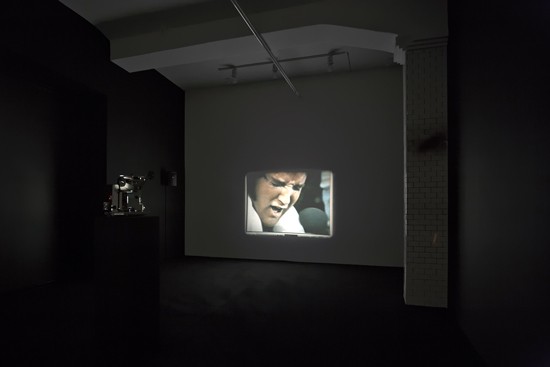 Installation view of Untitled (2007), 16mm film, sound, 7 min. Courtesy the artist & Hauser & Wirth, London/New York/Zürich.
Installation view of Untitled (2007), 16mm film, sound, 7 min. Courtesy the artist & Hauser & Wirth, London/New York/Zürich.
ART iT: You are known both for your paintings and your 16mm films, so there’s a lot to cover when discussing your work, but I thought we could start somewhere in the middle.
In 2007 I saw your exhibition at Hauser & Wirth in Zürich where you showed an untitled 16mm film with found footage of Elvis Presley doing a live performance of “Unchained Melody” shortly before he died. It was my first time seeing one of your films and it left a strong impression on me. What struck me was that the film encapsulated a uniquely transitory moment in society’s relationship to media and historical consciousness, since you were using 16mm film to document a computer with YouTube video of footage that had been shot in 1977.
Was that part of the intent of the work?
WS: I am aware of the idea that the film has these different convergences of media, but to be honest that’s simply how I use existing images. These images are all around us; they are part of our reality. It’s never been a particular intention of mine to criticize or play with them. I respond to them intuitively.
The film and the paintings that were in the exhibition were more or less about Graceland. While doing a residency in the US I made a trip to Memphis and I thought that since I was there I should see Graceland. But when you enter this empty house and see all the tourists walking everywhere, it is profoundly sad. And from being very cynical I responded to the specificity of that place. So I made paintings based on photographs I took of the interiors and began searching for Elvis on YouTube.
The songs in the film are both great songs. When I saw Elvis in that footage, he looked really insane. I think his insanity started quite earlier when he became totally detached from reality, having his handlers constantly “protecting” him. That’s what led me to also include the YouTube footage of Daniel Johnston singing “Casper the Friendly Ghost.”
ART iT: How about the film Widlik, also made in 2007, which features footage of your family at the beach alongside voice-overs recounting the story of a father who disappears from his family, and concludes with a scene of a computer on the beach playing a video of David Bowie singing “Space Oddity”?
WS: Widlik is a type of seaweed from the Baltic Sea. I’m a bit reluctant to show the film now because I don’t like the multiple narrators, I have to go back and record one person who will narrate the whole thing. But it’s just a made-up story that started from spending time together with my family at the coast and having the camera with me the whole time – this black body of the camera – and of course everyday quarrels about it, “You’re not playing with us!” That was how the story developed. “Space Oddity” fits at the end because it tells a similar story, with Major Tom flying away in space. And the computer was just what I happened to have on hand at the time.
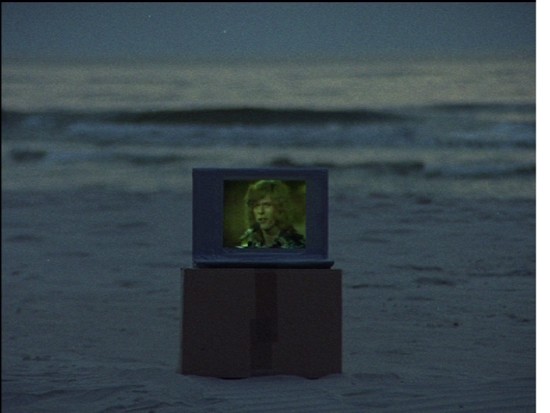
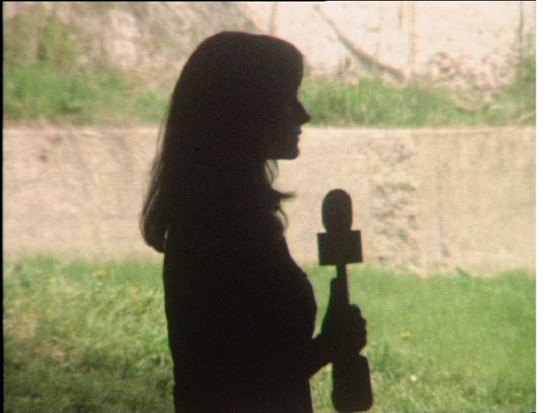
Above: Still from Widlik (2007), 16mm film, sound, 10 min. Below: Still from The Ranch (2006/07), Super8 film, transferred to DVD, 35 min.
ART iT: In addition to the untitled Elvis piece, you made several films during your stay in the US, including The Ranch (2006/07), which ends with this great scene of a female TV reporter shooting a report on location underneath a highway overpass. Wearing a mini-skirt and go-go boots, she is shown in soft-focus silhouette, and combined with the soundtrack of Vikki Carr singing the Burt Bacharach song “Anyone Who Had a Heart,” it looks like one of those early music videos from the 1960s or ’70s.
For me, the music accentuates the vanity of the reporter and the incongruity of her outfit at this very urban scene with a police barricade visible in the background. How much does music shape your films?
WS: Well, during my stay in the US I had a Super 8 camera with me and I filmed a lot of footage, so there is still more material that I plan to use. For the most part the footage is casual, I just happen to be there. The story behind the reporter is interesting. I was in Chicago, where there are large Polish and Mexican Catholic communities. Somebody noticed a stain on the wall of the underpass and thought it was a sign from the Virgin Mary. But it was just leakage. So people came and put flowers and lit candles in front of the stain, and I happened to be there when they were shooting the report. I think that when you turn the music off the films don’t exist. I’m currently planning a new feature-length film about greed in a Polish village, which will also make reference to events from World War II. When I imagine how the film will take shape I see it starting with documentary footage from the village where we will be shooting. As I play the images in my head, I know the exact music that I want to go with that footage.
ART iT: Yes, I was going to ask about your recent feature films, do you make them by yourself or do you have crews and multiple cameras?
WS: The films on display at Rat Hole Gallery right now are all small pieces that I did by myself without anyone around me. But in 2008 I made the film Swineherd, which centers on a swineherd who delivers clandestine letters between two young, lesbian lovers living in the Polish countryside. That was my first advanced, complex production. The outcome was a feature film almost 90 minutes long. Now we are finishing post-production on a second feature-length film, with a psychedelic plot set in a post-atomic reality.
Swineherd had a lot of art elements in it. There were several independent segments within the film, so I still had the excuse that it wasn’t a proper feature film, it was experimental. With the second film there is less experimentation, and I believe the third film that we are planning now will be a true feature film.
It’s been an ongoing process working with crews. Swineherd was totally chaotic because we were working with friends. For the second production we had a big crew but there were too many people even though it was a cheap production. There was no intimacy on the set at all. I hope with the third film we can find the right amount of people so that it’s neither chaotic nor crowded.
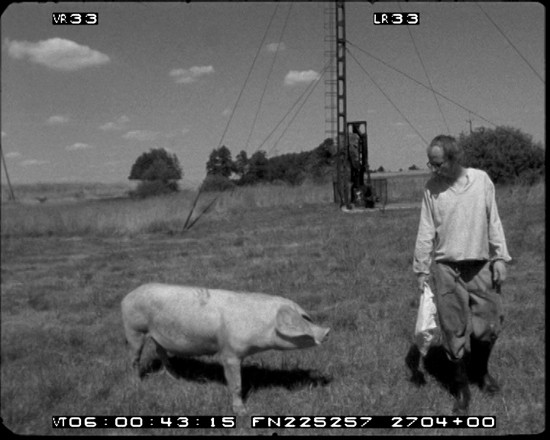 Still from the film Swineherd (2008), 35mm film, b/w, sound, 85 min 46 sec.
Still from the film Swineherd (2008), 35mm film, b/w, sound, 85 min 46 sec.ART iT: In that sense it seems that the short film Marfa (2005) is an important bridge from short to feature films as it is structured around this black Cadillac that you have refurbished and then stripped down to create a kind of performance and communal platform in the middle of the landscape, with a band using it as a stage and people lounging in the exposed back seat.
WS: That was actually the first longer film I did where it had a certain plot that I wrote for myself.
That was a very special moment for me. I was responding to my situation during my residency in Marfa. I met this band, and I knew I wanted this car for the film but I didn’t yet know what kind of film I was going to make. And the landscape was inspiring.
ART iT: Actually I thought the film had a subtle Land Art feel to it.
WS: That’s very good! I really like Land Art. It’s quite interesting about the land and the landscape. When I look at Old Master paintings, I love to look at the landscapes because I think these are still such incredible images. And it appeals to me because I can still see these landscapes now. In fact my interest in Land Art led me to make several paintings about Robert Smithson.
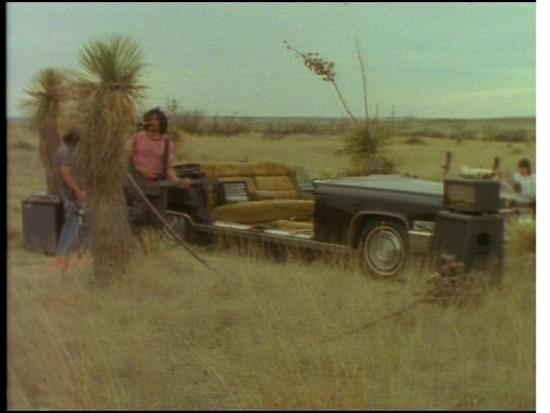 Still from Marfa (2005), 16mm film, sound, 25 min. Courtesy the artist, Anton Kern Gallery, New York, and Rat Hole Gallery, Tokyo.
Still from Marfa (2005), 16mm film, sound, 25 min. Courtesy the artist, Anton Kern Gallery, New York, and Rat Hole Gallery, Tokyo.ART iT: I wouldn’t necessarily have made the connection from simply looking at your paintings, but you put the ideas of painting, film and Land Art together.
WS: Yes. Again, it wasn’t my intention but that’s how it happened and now I can look back and understand my interests. When I told people I was going to Marfa they would all ask whether I was going to see Lightning Field and so on. I think it’s also a question of whether Land Art was about making a piece in the landscape or rather emphasizing what the landscape is about.
When we went to Spiral Jetty, it was such a tiny piece. It’s not impressive if you try to separate it from the landscape. The Great Salt Lake, that is the true piece of art. No one can compete with the landscape and its immensity.
Unless otherwise noted, all images courtesy the artist.
